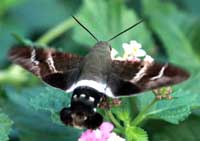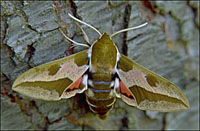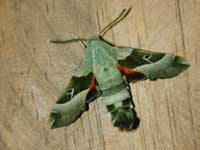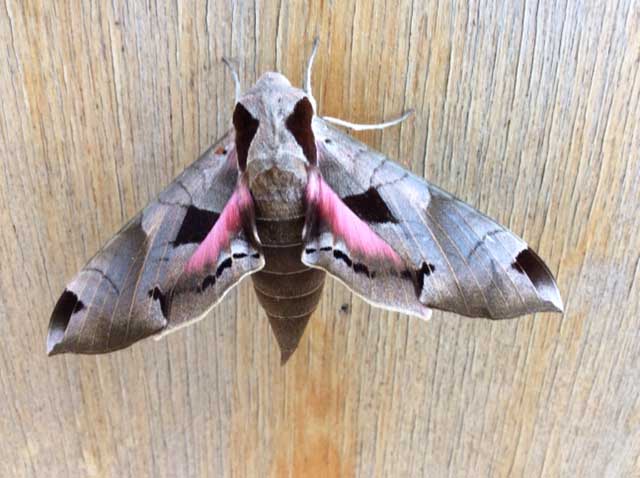Sphinginae subfamily
Sphingini tribe:
 |
Ceratomia amyntor
WO,
the Elm Sphinx or Four-horned Sphinx.
The upperside of the forewing is brown with dark brown and white
markings including a white costal area near the wing base, dark
streaks along the veins, and a white spot in the cell.
Larvae feed on Elm (Ulmus), birch (Betula), basswood (Tilia), and
cherry (Prunus). |
 |
Ceratomia undulosa
WO, Waved
Sphinx.
The upperside of the forewing is pale brownish gray with wavy black
and white lines and a black-outlined white cell spot.
It is named for the wavy lines on the forewings. |
 |
Manduca quinquemaculatus
WO,
Five-spotted Hawkmoth.
Abdomen usually has five but sometimes six pairs of yellow
bands. The upperside of the forewing is blurry brown and gray.
I suspect if you grow tomatoes, you are likely to encounter it.
|
 |
Sphinx chersis
WO,
the Northern Ash Sphinx or Great Ash Sphinx.
The upperside of the forewing is soft dark gray to blue-gray with a
series of black dashes, one of which reaches the wing tip.
|
 |
Forewings, long and slender, are held close to the body when the moth
is at rest.
|
 |
The upperside of the forewing has a narrow black subterminal line
bordered by a white inverted V-shaped line on the outside, and a
black line running inwards from the apex of the wing.
It is most often found in montane woodlands and along streamcourses.
|
Smerinthini Tribe:
 |
Amorpha juglandis
WO,
the Walnut Sphinx.
The adults are also highly variable; sometimes wings of an individual
may be all one color or may have several colors, ranging from pale to
dark brown, and may have a white or pink tinge. Patterns range from
faint to pronounced.
See the file for the female; she is different.
|
 |
Pachysphinx modesta
WO,
the Modest Sphinx or Poplar Sphinx
It is fond of poplars and
willows.
This moth has a large, heavy body, and females can be remarkably
plump. |
 |
The outer margin of the forewing is quite wavy. There is a dark cell
spot and a dark oblique line mid wing from the costa almost to the
inner margin. Basic ground colour is pinkish brown.
|
 |
Named for the small eye-spot in the hindwing, this moth has a wide
distribution. Both sexes rest with wings parallel to the resting
surface, with the upper lobes of the hindwings protruding above the
forewings.
|
 |
Smerinthus jamaicensis closely resembles Smerinthus cerisyi, but jamaicensis is much smaller with larger blue patches on more
vibrant and deeper purple in the lower wings.
|
 |
Smerinthus cerisyi,
the Cerisyi's Sphinx,
WO:
Similar to jamaicensis, but jamaicensis is smaller with larger blue patches on more vibrant, deeper
purple in lower wings. Also note complete (i.e. outer margin to outer margin) off-white arc just below fw apex.
In cerisyi, lower portion of arc does not return to outer margin.
|
Macroglossinae subfamily
Dilophonotini tribe:
 |
Aellopos titan
WO, the Titan Sphinx.
The body is dark brown with a wide white stripe across the abdomen.
The wings are dark brown. It is very similar to above species, but the
upperside of the hindwing has
pale patches along the costa and inner margin. if present, only as a stray
|
See Hemaris comparison to help distinguish
the next two species.
 |
Hemaris thysbe
WO, the Hummingbird Clearwing
It is not difficult to see why many gardeners would mistake an
Hemaris thysbe moth for a small hummingbird as it hovers,
sipping nectar from flowers through a long feeding tube.
|
 |
Hemaris diffinis
WO, the
Snowberry Clearwing or Bumblebee Moth
Adults mimic bumblebees and are quite variable, both geographically
and seasonally. The wings are basically clear, with dark brown to
brownish-orange veins, bases and edges. The thorax is golden-brown to
dark greenish-brown.
|
Philampelini tribe:
 |
This moth is fairly often reported along the coast from southern New Jersey to central Maine.
Note the differences between this moth and the Pandorus Sphinx. |
Eumorpha achemon, Aberdeen, July 17, 2017, Barb Griess
Macroglossini tribe:
 |
Darapsa myron
WO, Virginia Creeper Sphinx or the Grapevine Sphinx.
The forewing upperside is dark brown to pale yellowish gray, with an
olive tint.
On the costal margin there is a dark rectangular patch, although this
may be reduced or absent. The upperside of the hindwing is pale
orange.
|
 |
The moth's outer margin of the forewing is deeply scalloped.
The upperside is light brown with dark brown markings.
There is a small black and white spot near the tip
|
 |
Hyles euphorbiae
WO, the Spurge Hawk Moth
The body is light brown with various white and dark brown
markings, while the wings have a conspicuous tan, brown, and pink or
red color pattern.
|
 |
Hyles gallii WO, the Bedstraw Hawk Moth or Gallium Sphinx
Larvae feed on Epilobium angustifolium and Galium. I
expect flight is late May-July with a possible fall flight as well.
|
 |
Hyles lineata
WO, the White-lined Sphinx
The forewing upperside is dark olive brown with paler brown along the
costa and outer margin, a narrow tan band running from the wing tip
to the base, and white streaks along the veins.
|
 |
The upperside of the forewing is pale gray-green with a deep
green-brown median area and a white dash at the wing tip.
rare if present
|
 |
Sphecodina abbottii
WO,
the Abbott's Sphinx.
This moth is very much under reported across the United States. It
is a rapid day flier so is probably not in too many collections.
Grape and Virginia Creeper are popular larval hosts. generally more easterly
|
|
|


